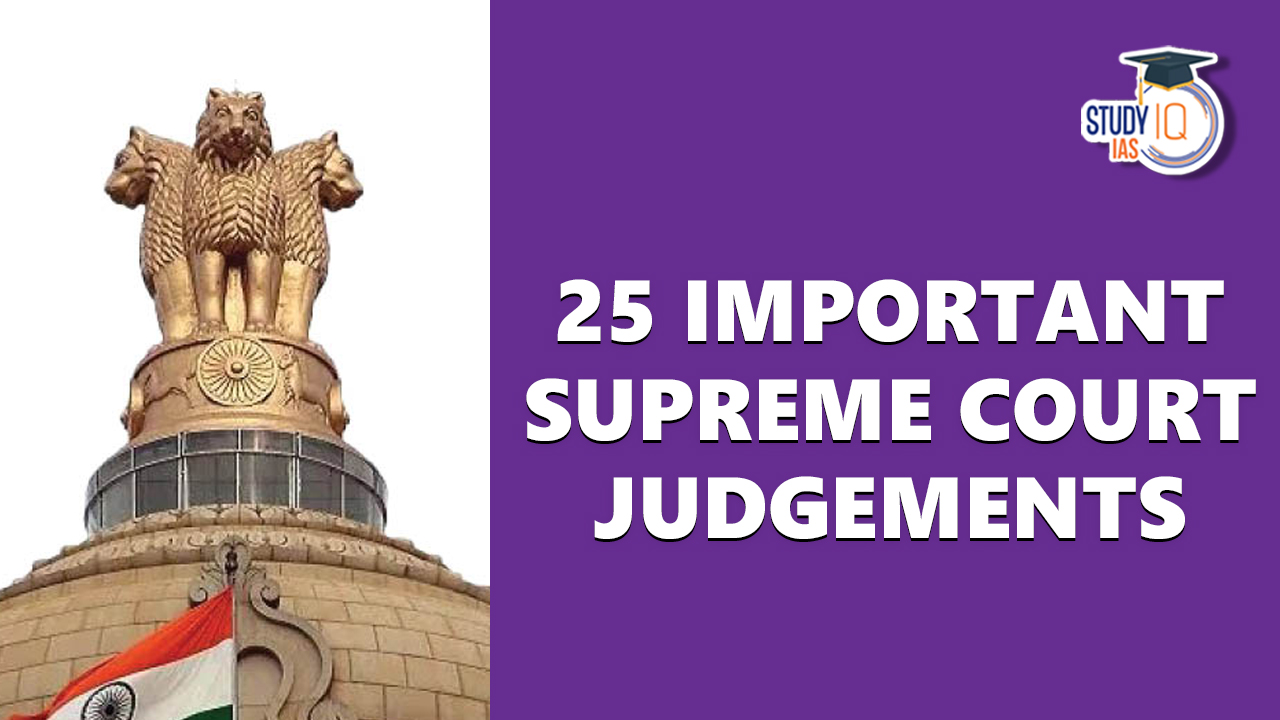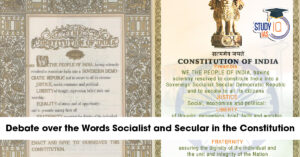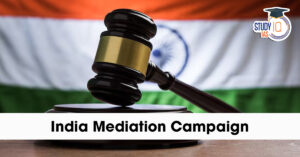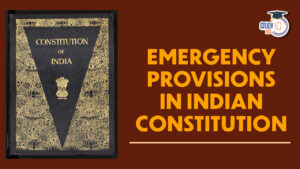Table of Contents
25 Most Important Supreme Court Judgements
Every candidate preparing for the forthcoming UPSC CSE exam must read the 25 Most Important Supreme Court Judgements. Our fundamental rights and freedom have been protected by the Supreme Court through its imaginative and original interpretation because it is the final decision-maker or interpreter of the Constitution. Cases like the AK Gopalan case, the Berubari union case, the Shankari Prasad case, and others have resulted in some of the Supreme Court of India’s most important rulings.
Important Supreme Court Judgements
Significant rulings by the Supreme Court of India establish a legal precedent, overturn a fundamentally important new legal theory or judicial notion, or significantly alter how the law is currently interpreted. A landmark ruling is a significant judgment that creates a new legal principle and changes how existing laws are understood. The Supreme Court (SC) is the highest court in India and serves as the final court of appeal. It can review its own decisions through a review petition. Generally, the SC does not overturn its rulings unless there is a strong reason, following the principle of stare decisis, which means respecting previous decisions.
The SC must operate in accordance with laws passed by the Parliament of India. However, if a bill passed by the Parliament is unconstitutional, the SC may declare it invalid. Additionally, the Parliament may change the Constitution in accordance with the basic structural theory.
Landmark Judgement of Supreme Court
1950 saw the adoption of the Indian Constitution. The Constitution has undergone numerous revisions since it was created. The Supreme Court of India makes important rulings based on the constitution, protecting our fundamental rights and freedoms. Its decisions are built on the legal precedents set by all levels of Indian courts.
| Case | Relevance |
| A.K. Gopalan Case (1950) | The SC ruled that as long as the imprisonment followed the legal process, there was no infringement of the Fundamental Rights entrenched in Articles 13, 19, 21, and 22 under the Preventive Imprisonment Act’s provisions. Here, the SC interpreted Article 21 in a limited manner. |
| Shankari Prasad Case (1951) | The constitutionality of the First Amendment was contested in this case, which concerned the amenability of fundamental rights. The SC argued that the Fundamental Rights granted in Part III of the Constitution are equally subject to the Parliament’s ability to alter under Article 368. |
| Berubari Union case (1960) | This case dealt with the Parliament’s authority to cede Berubai’s territory to Pakistan. The Supreme Court carefully considered Article 3 and determined that the Parliament cannot enact laws in order to carry out the Nehru-Noon Agreement. As a result, the 9th Amendment Act was passed to make the contract binding. |
| Golaknath case (1967) | In this instance, the issues at hand were whether or not amendments became laws and whether or not Fundamental Rights might be changed. According to the SC, Article 13’s restriction on parliament does not apply to fundamental rights, and a new Constituent Assembly would be needed to modify such rights. Additionally, it was argued that while Article 368 outlines the process for amending the Constitution, it does not grant Parliament the authority to do so. |
| Kesavananda Bharati case (1973) | The fundamental framework of the Constitution was established by this ruling. The SC ruled that although the Parliament had the authority to amend any portion of the Constitution, including the Fundamental Rights, the “basic structure of the Constitution could not be abrogated even by a constitutional amendment.” This is the legal foundation in India that allows the judge to invalidate any parliamentary amendment that conflicts with the fundamental principles of the Constitution. |
| Indira Nehru Gandhi v. Raj Narain case (1975) | The SC used the basic structure theory and invalidated Clause (4) of Article 329-A, which was added by the 39th Amendment in 1975, on the grounds that it was outside the scope of the Parliament’s amending power because it eliminated the fundamental elements of the Constitution. |
| Maneka Gandhi case (1978) | Whether the freedom to go abroad falls under Article 21’s definition of the freedom to Personal Liberty was a key question in this case. According to the SC, it is a part of the right to personal liberty. The SC further held that restricting personal freedom did not require more than the existence of an enabling law. Additionally, such a law must be “just, fair, and reasonable.” |
| Minerva Mills case (1980) | The Basic Structure concept is once again strengthened by this instance. The ruling declared two amendments introduced to the Constitution by the 42nd Amendment Act of 1976 to be in violation of the fundamental framework and invalidated them. It is made quite apparent by the ruling that the Constitution, not the Parliament, is superior. |
| Waman Rao Case (1981) | The Basic Structure theory was reaffirmed by the SC. Additionally, it established a boundary as April 24, 1973, the date of the Kesavananda Bharati ruling, and said that it should not be applied retroactively to examine the legality of any Constitutional modification that occurred before that day. |
| Shah Bano Begum case (1985) | A important case in the struggle for rights for Muslim women. The SC affirmed a Muslim woman’s claim to alimony and declared that everyone, regardless of religion, is subject to the 1973 Code of Criminal Procedure. The government of the day overruled this decision by introducing the Muslim Women (Protection on Divorce Act), 1986, which stipulates that alimony must only be paid during the iddat period (in accordance with Muslim personal law), sparking a political storm. |
| MC Mehta and Union Of India (1986) | Three issues were addressed in this case: the application of Article 32; the application of the Rylands v. Fletcher rule of absolute liability; and the compensation problem. The SC ruled that its authority under Article 32 extends to corrective actions as well as preventive ones where rights are violated. Additionally, it was decided that Absolute Liability should be used in industries that participate in risky or intrinsically harmful activity. Finally, it added that in order to act as deterrence, the compensation must be proportionate to the size and potential of the industry. |
| Indra Sawhney and Union of India (1992) | The scope and application of Article 16(4), which mandates the reservation of jobs for members of underprivileged sections, were scrutinised by the SC. With a few restrictions (such as the exclusion of the creamy layer, no reservations in promotions, and the total reserved quota shall not exceed 50%, etc.), it upheld the constitutional legitimacy of the 27% reservation for OBCs. |
| S. R. Bommai case (1994) | The SC attempted to stop the egregious abuse of Article 356 (concerning the imposition of the President’s Rule on states) in this ruling. |
| Vishaka and State of Rajasthan (1997) | This case involved workplace sexual harassment. In its ruling, the SC provided a set of instructions for employers and other accountable parties or organisations on how to right away assure the avoidance of sexual harassment. ‘Vishaka Guidelines’ are what these are known as. These were to be regarded as laws until the necessary legislation was passed. |
| Samatha and State of Andhra Pradesh (1997) | This verdict ordered the Andhra Pradesh State government to cease all mining operations and invalidated all mining leases it had issued in the Scheduled areas. It stated that land in scheduled areas, including forest property, tribal territory, and government land, may not be leased to non-tribal or commercial businesses for industrial purposes. This type of activity is only permitted for government-sponsored projects and tribe members. |
| Lily Thomas v Union of India (2000) | In this case, the SC ruled that a Hindu man’s second marriage is void if he did not divorce his first wife, even if he later converted to Islam, unless the previous marriage was ended in accordance with the Hindu Marriage Act. |
| I.R Coelho and State of Tamil Nadu 2007 | According to this ruling, laws that are listed in the Indian Constitution’s 9th Schedule are nevertheless subject to scrutiny and confrontation in court. There is a list of acts and laws that cannot be contested in court in the 9th Schedule of the Indian Constitution. The Waman Rao decision insured that the actions and legislation specified in the IX schedule up until 24 April 1973 would not be altered or contested, but that any attempt to do so would be closely scrutinised and examined by the judicial system. |
| Pedophilia case (2011) | Two UK citizens were found not guilty of paedophilia by the Bombay High Court, but the Supreme Court reinstated their conviction and 6-year (RI) severe prison sentences. One of the most terrible crimes, according to the court, is sexual abuse of children.” |
| Aruna Shanbaug Case (2011) | Passive euthanasia is permitted under certain conditions after the SC determined that people have a right to a dignified death. Aruna Shanbaug’s terrible story, in which she spent 42 years in a vegetative condition while blind, crippled, and deaf, served as the impetus for changes to India’s euthanasia laws. |
| NOTA judgement (2013) | This ruling gave Indian voters the NOTA (None-Of-The-Above) option. |
| Lily Thomas and Union Of India (2013) | The SC held that any MLA, MLC, or MP who was convicted of a crime and sentenced to at least two years in jail would immediately lose their right to serve in the House. |
| Nirbhaya Case (2014) | A definition of rape under the Protection of Children from Sexual Offences Act, 2012, the Indian Evidence Act, 1872, the Indian Penal Code, 1860, and the Code of Criminal Procedures, 1973, as well as the introduction of the Criminal Law (Amendment) Act, 2013. |
| National Legal Services Authority and Union of India (2014) | As a result of this decision, transgender people are now recognised as a third gender. The SC further ordered the government to treat them as minorities and to increase reservations in employment, education, and other fields. |
| Triple Talaq Judgement (2016) | The SC prohibited the antiquated practise of quick “triple talaq,” which allowed Muslim men to dissolve their marriages unilaterally by saying “talaq” three times without providing for support or alimony. Read more about the 2019 Triple Talaq Bill. |
| Right To Privacy (2017) | The Supreme Court held that the Indian Constitution protects the right to privacy as a Fundamental Right. |
| Repealing Section 377 (2018) | Insofar as it criminalises consensual sexual activity between adults of the same sex, the SC concluded that Section 377 is unconstitutional.” |
| L Chandra Kumar Case (1997) | The Supreme Court declared that Articles 32 (Right to Constitutional Remedies) and 226 (Judicial Review Power) of the Constitution, which grant the Supreme Court and High Courts respective judicial review authority, are fundamental elements of the Constitution. |
| Puttuswamy Case (2017) | This Supreme Court ruling defends individuals’ rights against invasions of their privacy. |
| Habeas Corpus Case (1976) | A highly criticised Supreme Court decision in which the majority decision appeared to benefit the state while opposing individual freedom. The dissension of Justice Khanna is likewise well-known. |
| Romesh Thapar Case (1950) | In this case, the SC ruled that the freedom of speech and expression includes the freedom of idea dissemination, which is only possible through circulation. |
The Supreme Court of India has ruled in a number of significant instances that demonstrate how it has defended individual rights over time. The Supreme Court is tasked with defending a person’s rights in accordance with the constitution. The Supreme Court changes the law to provide people with justice in addition to defending individual rights. These stories amply demonstrate that anyone can expect and seek justice in a court setting.
Top Supreme Court Judgements 2023
- Article 370 Challenge: The Supreme Court upheld the government’s decision to revoke Jammu and Kashmir’s special status, stating Article 370 was a temporary provision. They ruled that the presidential orders for abrogation were valid but found some amendments unconstitutional.
- Marriage Equality Plea: The court rejected petitions for equal marriage rights for sexual minorities, stating there’s no constitutional right to marry. They emphasized that marriage is based on social customs, not legal rights. Transgender persons in heterosexual relationships do have the right to marry.
- Maharashtra Political Crisis: The court declared the Governor’s order for a floor test illegal due to lack of evidence. They recognized Uddhav Thackeray’s resignation as voluntary and left the disqualification of rebel MLAs to the Speaker.
- Delhi Governance: The Supreme Court ruled that the Delhi government controls its civil servants, not the Lieutenant Governor, reinforcing local governance while acknowledging the Union’s oversight in specific areas.
- Election Commission Appointments: The court changed the process for appointing Election Commission members, creating a committee that includes the Chief Justice, Prime Minister, and Leader of Opposition to ensure independence from the executive.
- CBI and ED Directors’ Tenure: The court upheld the government’s ordinances allowing tenure extensions for CBI and ED directors but ruled that a specific extension was illegal. They emphasized the need for independence in investigative agencies.
- Jallikattu Practice: The court upheld the bull-taming sport of Jallikattu, stating it’s part of Tamil Nadu’s culture, while dismissing previous bans as infringing on cultural practices.
- Euthanasia and Dignity: The court streamlined guidelines for withdrawing treatment from terminally ill patients, making the process easier while affirming the right to die with dignity.
- Direct Divorce Powers: The Supreme Court asserted its authority to grant divorce in irretrievable breakdown cases, emphasizing a more flexible approach rather than strictly following existing laws.
- Unstamped Arbitration Agreements: Initially, the court ruled that unstamped arbitration agreements were void, but later reversed this, stating that lack of a stamp is a correctable issue, allowing such agreements to be enforceable.
25 Important Supreme Court Judgements UPSC
Judgements from the Supreme Court of India are relevant to the UPSC Syllabus. And it is an important subject for the Preliminary, Main, and Interview rounds. According to the curriculum, UPSC candidates must concentrate on all the details and material pertaining to Supreme Court of India judgements.


 Indian Secularism: Constitutional Provis...
Indian Secularism: Constitutional Provis...
 India Mediation Campaign, Objectives, Pr...
India Mediation Campaign, Objectives, Pr...
 Emergency Provisions in Indian Constitut...
Emergency Provisions in Indian Constitut...





















